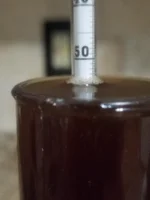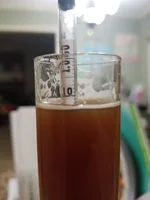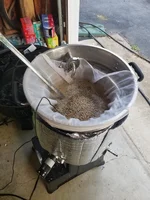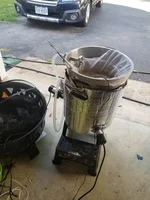The Rye or the Kaiser (2021-08-05)
- Brewed: Aug. 5, 2021
- Packaged: Aug. 17, 2021
- On Tap: N/A
- Recipe: The Rye Or The Kaiser
This is my first brew with my new Unibrau 10g setup. Due to some unfortunate electrical and customer support issues, I was not able to properly use the mashing functionality. I had to just heat to mash in temp and maintain it with insulation and occasional kicking on of the heat manually. The kettle and lid are wrapped in Reflectix. This was just a test run, so I did a pretty sloppy job with it and did not attempt to maintain a proper air gap all around. The Reflectix still helped, getting me from "barely boiling" at 208F to a solid rolling boil at 212F.
Preboil SG: N/A
Original gravity: 1.055
Final gravity: 1.013
Volume in Fermenter: 4.9 Gallons
Mash and Boil Process
I did a full volume BIAB no sparge mash as usual, but with all new equipment and at new volumes. I started with about 7.2 gallons of water for this larger batch. That was based on initial boil off tests suggesting a very low 0.75 gallons/hr boil off rate. I knew this was low, but it was what I got with multiple tests. I added reflectix around the kettle and over the lid which definitely increase by boil vigor and so seems to have caused a more normal boil off rate. I may have also had a higher grain absorption than I normally do due to the larger grain amount and not being able to squeeze it out as much as with the smaller batches. I mashed starting at around 152F and ending around 146F. Due to the equipment issues I was not able to use the controller's mash mode to main temperature and instead had to use boil mode to heat to strike temperatures and rely on insulation and occasional application of heat as in the past with my stove top brews. Since I was in a bit of a rush trying to do this on a work day with a bit of disorganization I did not take a pre-boil gravity reading.
After mashing I boiled for 90 minutes, adding my hops after 30 minutes to give them a 60 minute boil. Afterwards I used my immersion chiller to get the wort down to about 80F which was about the temperature of the ground water. I then left the wort in the kettle for several more hours with the kettle in my fermentation chamber as well as it would fit. I eventually transferred to my fermenter and let it cool to about 70F. At 70F I pitched the yeast and warmed to 72F and then let it naturally rise to between 75F and 77F. This was based on talking to the owner of my local homebrew shop and further research into WB-06 fermentation temperatures since it is significantly different from a normal wheat/hefe yeast.
While boiling I seem to have severly overshot my color. I'm not sure if there was a mismeasurement of some of the grains or some serious caramelization during the boil. Based on the burnt on funk on my heating element, I assume caramelization. I am hoping the flavor is not negatively effected. I also hope this is not a problem for every batch and just a result of temperature controller issues or wonkiness from the very rye heavy grain bill causing some difference in the sugars, although it was not an issue with past brews using the same recipe on the stove top. I have since added the photo of this same batch when taking my final gravity reading and this appears to be closer to the expected color from previous batches.
Fermentation
Yeast was pitched at between 70F and 72F. It was then allowed to rise naturally to between 75F and 76F and maintained at that temperature for 7 days. After that I stopped providing any cooling, letting the natural temperatures of the weather and storage space take over since it was past the point that off flavors from the yeast would happen.
2021-08-18
The batch has now been kegged with priming sugar. Fermentation took off very quickly, with krausen starting to form after maybe six hours. The wort stayed very yeasty and hazy for nearly a week before the yeast really settled out of suspension. Based on my kegging day sample, the increased pitching and fermentation temperature helped a lot with this yeast. It has provided much more flavor than the previous batches.
2021-09-04
I finally have this beer on tap. Fermenting at 75F, which is extremely warm for a hefe yeast, worked out great. Previous uses of this yeast were sort of interesting, but not the flavors I was going for. I knew the yeast was weird, and so fermented at higher than normal hefe yeast temperatures, but not as high as this time. For this batch I've got plenty of clove and some fruit from the yeast as expected.
Style Details
| O.G. | F.G. | IBU | Color |
|---|---|---|---|
| 1.046 - 1.056 | 1.010 - 1.014 | 10 - 20 | 14 - 19 srm
|
Batch Details
| Brewed On | Packaged On | On Tap Date | Original Gravity | Final Gravity | Color |
|---|---|---|---|---|---|
| Aug. 5, 2021 | Aug. 17, 2021 | N/A | 1.055 | 1.013 | 18 srm |





